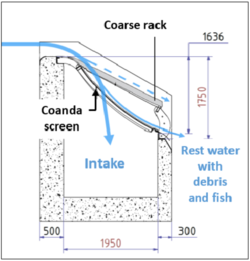Bottom-type intakes (Coanda screen, Lepine water intake, etc)
Contents
Introduction
In mountainous regions, some of the water intakes are of bottom-type, also called Tyrolean intakes, particularly on streams with great sediment transport and sites with complex access. In France, we count many examples of these water intakes, below 1500-1000 m altitude, with natural population of trout upstream. The rack or the perforated plate is included within the downstream weir face, more or less inclined in the downstream direction, so that the trashes and sediments are pushed out by the flow (self-cleaning intake). Three types of such intakes exist:
- “Classical” bottom-type intake: the water goes through a rack with longitudinal bars, more or less inclined in the downstream direction (Figure 1).
- Lépine water-intake: the water falls on a perforated plate. This kind of water-intake is quite frequent in France (Figure 2).
- Coanda water intake: the water goes through a rack with transversal bars using the Coanda effect (Figure 3 and 4).
"Classical" bottom-type intake
Lépine water intake
Coanda intake
A Coanda screen is an overflow intake, where the water runs over a weir and then through a fine-mesh screen and is normally used on small hydro projects. The Coanda screen is bent so that it is self-cleaning and can be built with a small gap width of 0.5-6 mm.
Most of the water passes through the screen, while fish, debris and some water (residual water) are flushed further down. Buell (2000) found that both salmon smolt and fry can pass Coanda screens undamaged. The screen has openings between 0.5-6 mm, with vertical splines in the direction of flow. The water can flow through the bars while fish, sediments and driftwood are flushed repeatedly. In order to ensure that the fish are not damaged, a pool must be provided downstream of the intake so that the fish lands in water and not on stone or the like. This pool can also act as a flood energy repellent. Any predation should be monitored and handled as needed. The intake must be dimensioned so that water flow is maintained along the entire grid, both to ensure residual water and that the fish does not strand on the screen. If water discharge can be less than dimensioned values, the functional capacity must be ensured by gradually narrowing the screen or by ensuring that residual water is secured by, for example, a minimum flow system (Bureau of Reclamation 2006). Fish on the screen may be subject to predation from the bird and it should be considered netting. The system can also be used to count downstream migratory fish (like a Wulf trap). In that case, fish must be directed to a fish counter or storage pool for manual counting.
Methods, tools, and devices
During planning
A Coanda screen is planned as a conventional dam and intake. A hydrological and sediment analysis must be conducted to investigate the river discharge over time and to clarify hydraulic forces. The planning of the construction is based on civil engineering to design the dam, the screen and the adjacent construction elements, such as roads and buildings. The screen will be planned as part of the dam.
During implementation
Physical implementation of a Coanda screen requires heavy machinery suited for the river size and its surrounding terrain, such as excavators and lorries. The dam is normally in concrete and requires casting, iron reinforcement and forming. Screen will be fixed to the dam after the dam is finished.
During operation
A Coanda screen normally does not need much maintenance but all structures in rivers must be monitored and maintained to ensure that functions related to flow and sediments are restored, such as flood events and connectivity of the sediments. The frequency of the maintenance will be very site-specific.
Relevant MTDs and test cases
Classification table
| Classification | Selection |
|---|---|
| Fish species for the measure | All |
| Does the measure require loss of power production | Operational (requires flow release outside turbine) |
| - | |
| - | |
| Recurrence of maintenance | Irregular at events |
| Which life-stage of fish is measure aimed at | - |
| - | |
| - | |
| Movements of migration of fish | |
| Which physical parameter is addressed | N/A |
| - | |
| - | |
| - | |
| - | |
| - | |
| - | |
| - | |
| Hydropower type the measure is suitable for | Plant in dam |
| Plant with bypass section | |
| Dam height (m) the measure is suitable for | All |
| Section in the regulated system measure is designed for | In dam/power plant |
| - | |
| - | |
| - | |
| River type implemented | Steep gradient (up to 0.4 %) |
| Fairly steep with rocks, boulders (from 0.4 to 0.05 %) | |
| Slow flowing, lowland, sandy (less than 0.05 %) | |
| Level of certainty in effect | Very certain |
| Technology readiness level | TRL 9: actual system proven in operational environment |
| Cost of solution | See cost table |
Relevant Literature
- Buell, J.W. 2000. Biological Performance Tests of East Fork Irrigation District’s Sand Trap and Fish Screen Facility: Phase I 1999, Buell and Associates, Inc., Portland Oregon, 24p.
- Bureau of reclamation. 2006. Fish Protection at Water Diversions. A Guide for Planning and Designing Fish Exclusion Facilities. Water Resources Technical Publication. U.S. Department of the Interior. Bureau of Reclamation. Denver, Colorado. 480p.



